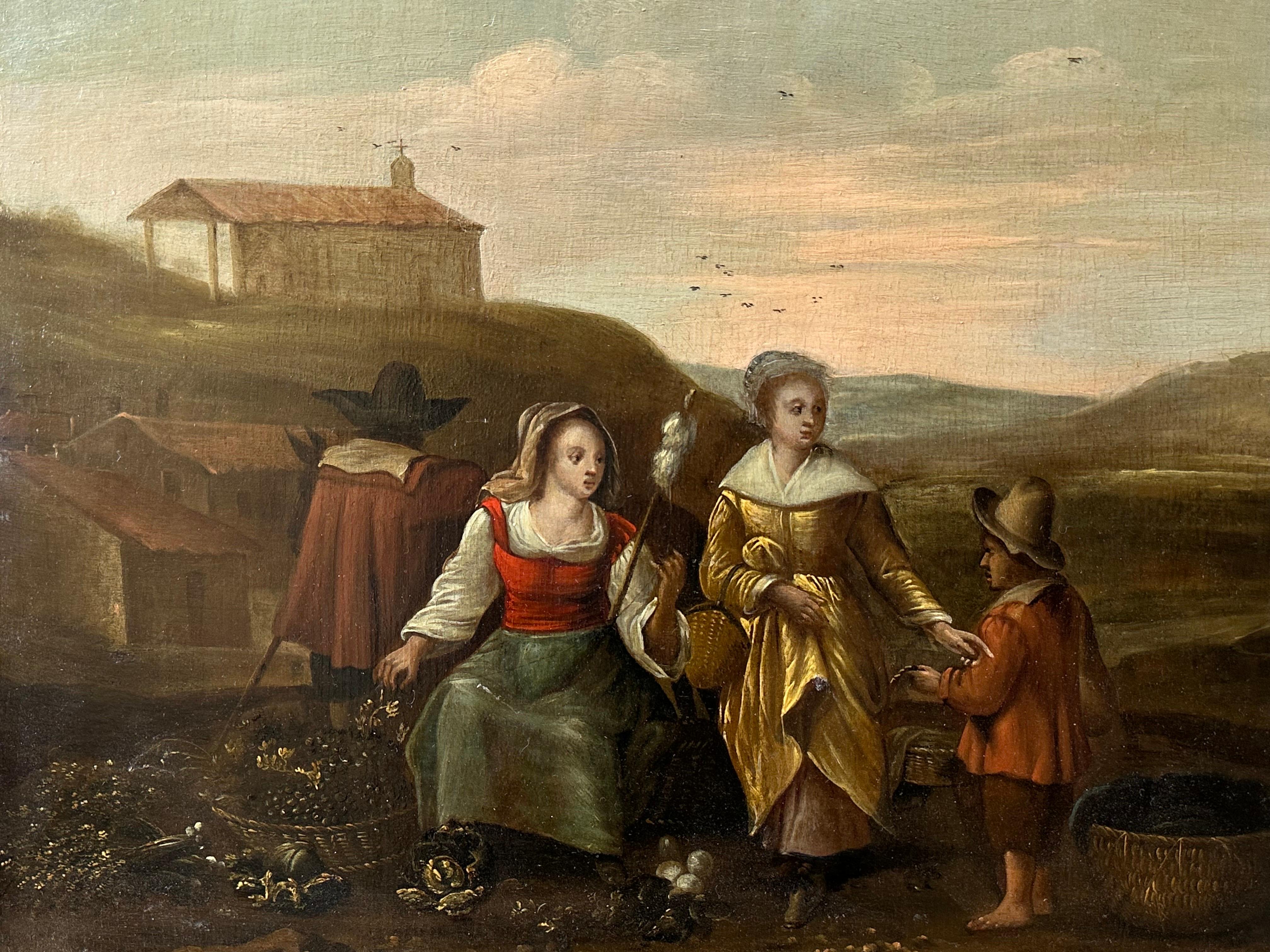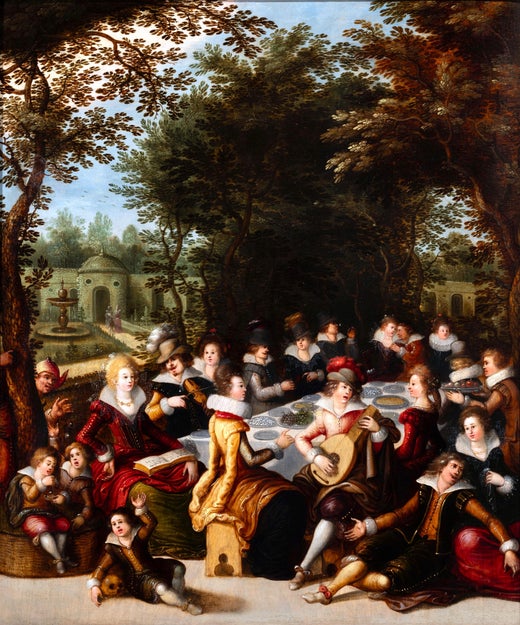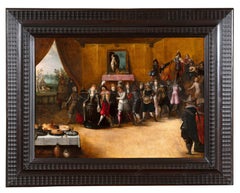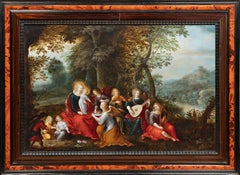Items Similar to Feast in the Garden of Love, 17th century Antwerp, Louis de Caullery
Want more images or videos?
Request additional images or videos from the seller
1 of 15
Louis de CaulleryFeast in the Garden of Love, 17th century Antwerp, Louis de Caullery
$32,113.02
£23,916.75
€27,000
CA$45,040.12
A$49,404.67
CHF 25,476.13
MX$590,089.64
NOK 323,114.81
SEK 303,118.36
DKK 205,805.94
About the Item
Louis de Caullery (1582-1621)
Antwerp School early 17th century
Oil on oak panel
Dimensions: h. 51 cm (20.08 in), w. 43 cm (16.93 in)
Ebonized wooden frame
Framed: h. 67 cm (26.38 in), w. 59 cm (23.23 in)
Our work is registered in the RKD database under the number 214025 (The Rijksbureau voor Kunsthistorische Documentatie, headquartered in The Hague in the Netherlands, is one of the most important documentation centers specializing in the history of art)
Provenance:
- private collection, United Kingdom - Christie's sale, November 5, 2003, lot no. 32
- 1983-2003 Jan Lipinski Collection, Frankfurt, Germany - Sotheby's sale, London, 23 June 1982, lot 37
- before 1982 collection of the princes of Schaumburg-Lippe at Bückeburg Castle, Germany
Our painting with a prestigious princely provenance illustrates a scene of a gallant meeting taking place in a park. The elegant figures, richly dressed in Renaissance fashion, are seated in the shade of the trees enjoying wine, delicious food and music. To the sounds of violins and lutes are added the trickling of a fountain. Time seems to stand still in these gastronomic and romantic celebrations.
The theme of courtly love treated here derives from medieval iconography of the “garden of love” type. It was brought back into fashion by the Antwerp painters of the genre (Sebastien Vrancx, David Vinckboons and Louis de Caullery): the gallant assemblies made up exclusively of the upper bourgeoisie celebrated love and the joy of living. However, a moralizing message associated with another theme is cleverly concealed by the painter and is only discernible by the artifice of a small scene in the foreground, the young pages having fun blowing soap bubbles, while a little boy is lying on the skull. An unexpected character also seems to be part of the feast: a jester recognizable by his cap hides behind a tree spying on the merry company.
This is how, in fact, beyond the pleasant and apparently superficial character of the painting, the theme of Vanity is revealed through its attributes: the soap bubbles signify the fragility of life which bursts, the skull is the symbol of death, the jester symbol of human madness is ultimately the only lucid being. Thus all his intruders into the festivities admirably placed by the painter in the composition serve to make us reflect on the brevity of life and love, the transience of earthly pleasures and the artist invites the viewer to concentrate on the life of the 'beyond.
It is important to emphasize that at the end of the 16th century and beginning of the 17th century, Vanity is often associated with a young child, in itself a symbol of the ephemeral nature of youth, leaning or sitting on a skull, having fun blowing soap bubbles, sometimes in the presence of a vase from which smoke escapes. These are the main symbols of the transience of time in use late 16th century, before the vanities triumphed, in the 17th century, through the genre of still life.
Louis de Caullery seems to have been particularly interested in the representation of gallant scenes, through different subjects: festivals, carnivals, allegories of the senses are all pretexts for the representation of groups of animated and colorful characters. The numerous small figures meticulously executed in skillfully sought-after and varied postures, the vibrant rendering of the costumes, the attention paid to details, all its characteristics are specific to the works of Louis de Caullery, who likes to depict small elegant figures richly dressed in lush landscapes or rich palace interiors.
- Creator:Louis de Caullery (1580 - 1621, Belgian, French)
- Dimensions:Height: 26.38 in (67.01 cm)Width: 23.23 in (59.01 cm)
- Medium:
- Movement & Style:
- Period:Early 17th Century
- Condition:
- Gallery Location:PARIS, FR
- Reference Number:1stDibs: LU2433214457842
We have little information on the origins of the artist. He was probably born in Cauery, the town whose name he ended up taking and which is located 18 km from Cambrai. He probably maintained ties with this region. In 1594 he was recruited under the name of "Loys Solleri" as an apprentice of the landscape gardener Joos de Momper. When he became master of the Guild of Saint Luke in Antwerp in the list of 1602-1603, he registered under the name of "Lowis Callori."
Caullery was a prolific painter of genre scenes and mythological paintings. His elegant style is oriented towards late mannerism. His multi-figure compositions have aptly been compared to the work of Frans Francken and other mannerist masters. Small-scale figures are depicted in huge squares, interior scenes or in a landscape with a very large depth of field.
His mixture of genre scenes and landscape painting is thoroughly Nordic and even when he introduced mythological and religious themes it was in the manner of a non-heroic genre painter.
There are no signs of stylistic evolution in his work. Some paintings are dated but they mainly belong to the end of his career, such as the Allegory of the senses of 1618, at the castle of Nelahozeves in Poland, or another version of the same subject, dated 1620 and on deposit at the Museum of Fine Arts de Cambrai, as well as the Crucifixion of 1619 at the Brussels Museum. Given the large number of works that have come down to us and the repetition of certain compositions, it seems that Caullery directed a large and very active workshop.
About the Seller
No Reviews Yet
Vetted Professional Seller
Every seller passes strict standards for authenticity and reliability
1stDibs seller since 2023
17 sales on 1stDibs
- ShippingRetrieving quote...Shipping from: PARIS, France
- Return Policy
Authenticity Guarantee
In the unlikely event there’s an issue with an item’s authenticity, contact us within 1 year for a full refund. DetailsMoney-Back Guarantee
If your item is not as described, is damaged in transit, or does not arrive, contact us within 7 days for a full refund. Details24-Hour Cancellation
You have a 24-hour grace period in which to reconsider your purchase, with no questions asked.Vetted Professional Sellers
Our world-class sellers must adhere to strict standards for service and quality, maintaining the integrity of our listings.Price-Match Guarantee
If you find that a seller listed the same item for a lower price elsewhere, we’ll match it.Trusted Global Delivery
Our best-in-class carrier network provides specialized shipping options worldwide, including custom delivery.More From This Seller
View AllFlemish 17th c., Allegory of war and peace, circa 1630, by Adriaen van Stalbemt
Located in PARIS, FR
Adriaen van Stalbemt (Antwerp, 1580-1662)
Allegory of Peace and War, circa 1620-1630
Oil on oak panel: h. 49.5 cm, l. 73.2cm (19.29 x 28.74 in)
Giltwood ...
Category
Early 17th Century Old Masters Figurative Paintings
Materials
Oil, Panel
Attributed à H. Francken II, 17th c. Anwerp - The prodigal son among courtesans
Located in PARIS, FR
The Prodigal Son Among Courtesans
Attributed to Hieronymus Francken II (Antwerp 1578-1623)
Early 17th century Antwerp school
Oil on oak panel,
Dimensions: H. 52.5 cm (20.67 in), W. 74 cm (29.14 in)
Flemish-style moulded wood frame
Frame: h. 78 cm (h. 30.70 in.), w. 100 cm (39.37 in.)
At first glance, this festive and joyful painting depicts a group of elegantly dressed people dancing to the sound of an orchestra in a richly decorated interior with a wide opening onto a rural exterior. However, the real theme is cleverly concealed by the painter and is only discernible through the artifice of a small scene in the background where we see a half-naked man, in the company of the pigs next to a makeshift shelter.
In fact, beyond the pleasant and apparently superficial character of the painting, it is a subject taken from the parable of the prodigal son in the Gospel. The illustrated episode is the prodigal son among courtesans.
Even if the viewer's attention is drawn to the central couple (prodigal son embracing a pretty courtesan) doing the dance steps, the artist takes care in a narrative approach of all the groups and ancillary scenes in order to create a rich and varied composition. Thus the musicians seated on a raised platform are depicted with great skill, their faces animated, their clothes abundantly varied.
The theme of music, which has always been associated with that of sensuality and physical love, helps to exacerbate licentious pleasures.
The merry company dances "Spanish pavane", a slow court dance from the sixteenth century, danced close to the ground by couples arranged in a procession, which was probably introduced to the south of the Netherlands around 1600 during the governance of Albrecht VII and the daughter of the King of Spain Isabella Clara Eugenia in Brussels.
The interior of the house is also carefully elaborated, the embossed leather dyes on the walls, the middle sideboard (typical in Francken interiors), where the rich gold and silver crockery is placed in front of the painting "Andromeda chained to the rock and Perseus arriving to rescue her". The inclusion of a contemporary and probably extant pictorial work is also one of the characteristics of the Francken family, among them Frans Francken the Younger...
Category
Early 17th Century Old Masters Interior Paintings
Materials
Oak, Oil
Madonna and Child with Angels, attributed to Louis de Caullery, Flemish, 17th c.
Located in PARIS, FR
Madonna and Child with Angels
Attributed to Louis de Caullery (1565 -1622) for figures & Abraham Govaerts (1589 - 1626) for landscape
Not signed
17th century Antwerp school, circa 16...
Category
Early 17th Century Old Masters Figurative Paintings
Materials
Copper
Allegory of Summer, workshop of Hendrick Van Balen 17th c. Antwerp school
By Hendrick van Balen
Located in PARIS, FR
Allegory of summer, personified by Ceres
Workshop of Hendrick Van Balen
Antwerp School, early 17th century.
Oil on copper,
Dimensions: h. 52 cm, l. 40cm
Antic giltwood frame
Framed dimensions: h. 74 cm, l. 60cm
Very good condition
Our delicately painted work is part of the pictorial tradition that is both allegorical and mythological in vogue in Antwerp, whose leaders are Jan Brueghel the Younger and Hendrick Van Balen. Numerous works emerging from their workshops illustrate mythological subjects, the seasons, the elements, the senses or intertwining the lush landscapes, animals and gods of Olympus.
At the heart of a green landscape dominated in its center by a generous apple tree, the beautiful Ceres, partially dressed in a large blue drape, is wearing a crown of ears of wheat, her symbol of the goddess of the earth and harvests. She holds the sickle in her right hand and carries sheaves of wheat. To her right a nymph holds the cornucopia while puttis pick and offer flowers.
In the foreground are the summer fruits: figs, cherries, apples and lemons. A squirrel munching on cherries symbolizes toil and foresight, themes that are echoed in the work of the harvesters on the wheat fields in the background.
The background is composed of vegetation, on the right a wild rose bush with its branches erect against a tree trunk, in the center of the trees with silvery green foliage.
Our painter, a student of Hendrick Van Balen, finds his inspiration in the works of the master such as this nymph in yellow drapery seen from behind, one of the figures which accompanies many of the master's paintings. The elegant gestures, the flesh...The indisputable influence of Jan Brueghel the Younger is revealed in the treatment of trees and flowers, wild roses, tulips as well as in the still life with the squirrel in the foreground.
The craze for this type of virtuoso painting where the mythological figures are only a pretext to better illustrate the landscape and plant species surrounding them, then generated orders from all over Europe.
Hendrick Van Balen, Flemish painter, born and died in Antwerp (1575-1632). A student of Adam Van Noort, he entered the guild of Saint-Luc in 1593, later trained in Italy and was Van Dyck's first master. He often painted small characters taken from scenes from the Bible or classical mythology, on paintings in which Josse de Momper...
Category
Early 17th Century Old Masters Figurative Paintings
Materials
Copper
The Rape of Europa, signed Peter Sion (1624-1695), Antwerp, 17th century
Located in PARIS, FR
The Rape of Europa
By Peter Sion (Antwerp, 1624-1695)
Signed in the lower right corner P. Sion
17th century Antwerp School
Oil on copper, dim. h. 53 cm, w. 45 cm
Moulded and ebonized...
Category
17th Century Old Masters Figurative Paintings
Materials
Oak, Oil, Wood Panel
The Musical Contest between Apollo and Marsyas, signed P. Sion, Antwerp 17th c.
Located in PARIS, FR
The Musical Contest between Apollo and Marsyas,
by Peter Sion (Antwerp, 1624-1695)
Signed in the lower right corner P. Sion
17th century Antwerp School
Oil on copper, dim. h. 53 cm, ...
Category
17th Century Old Masters Figurative Paintings
Materials
Oak, Oil, Wood Panel
You May Also Like
Huge 1700's Dutch Old Master Oil Painting Elegant Court Figures Musical Soiree
Located in Cirencester, Gloucestershire
Artist/ School: Dutch School, early 1700's.
Title: Elegant Court Figures at a Musical Soiree.
Medium: oil painting on canvas, unframed.
Size: painting: 40 x 49.5 inches
Provenanc...
Category
Early 18th Century Figurative Paintings
Materials
Canvas, Oil
Banquet Attrib to Van Den Hoecke Religious Oil on Table Old Master 17th Century
By Gaspar van den Hoecke (Antwerp, 1585 - 1648)
Located in Riva del Garda, IT
Gaspar van den Hoecke (Antwerp, 1585 - 1648)
Herod's banquet
Early 17th century
oil on panel, with gold highlights (in the guise of Salome and in the curtains of the building in the background)
56 x 80 cm.
framed 72 x 90 cm.
Note: The painting probably dates from an original by Frans II Francken (1581 - 1642), which is shown under the number 0000344789 in the RKD.
Valuable oil painting on panel depicting King Herod and the beautiful Jewish princess Salome according to the episode taken from the Gospel of Matthew (14.3-11), which sees her as the protagonist in the story of the martyrdom of John the Baptist. The event shown is a cross between history and legend, a myth faced for centuries by artists in every field: Caravaggio in painting, Oscar Wilde in theater, Richard Strauss...
Category
17th Century Old Masters Paintings
Materials
Oil
$15,461 Sale Price
20% Off
18th century French Garden or Féte a Bride and musicians playing music
Located in Woodbury, CT
This enchanting 18th-century French fête galante captures the elegance and joy of aristocratic leisure, set amidst a lush garden adorned with flowers. A scene of refined celebration,...
Category
1780s Old Masters Figurative Paintings
Materials
Canvas, Oil
Fete Champetre - Garden Party - French 18thC figurative landscape oil painting
Located in Hagley, England
This charming 18th century French Old Master oil painting is attributed to circle of Joseph Frans Nollekens. Painted circa 1740 it is described as a fete champetre - a form of entertainment in the 18th century, taking the form of a garden party. They were often elegant affairs and became very popular in 18th French paintings. Antoine Watteau invented the genre, from around 1710 and they were also included as a category in the French Academy. In this painting, several well dressed figures are sat in the foreground by a fountain and statue, being entertained by a musician. Beyond, a wide avenue of trees leads towards a very grand country house with countryside beyond. There is superb detail in the figures and their colourful clothing. The brushwork in the trees and sky is also superb. This is a charming example of an 18th century fete champetre and of a French Old Master oil painting.
Provenance. Gloucester estate.
Condition. Oil on canvas. Image size 49 inches by 30 inches and in good condition.
Frame. Housed in a fine gilt frame, 56 inches by 37 inches and in good condition.
Josef Frans Nollekens or Joseph Frans Nollekens (1702–1748)[2] was a Flemish painter who was principally active in England where he is often referred to as "Old Nollekens" to distinguish him from his famous son, the sculptor Joseph Nollekens. He painted conversation pieces, galant companies and fêtes champêtres in the style of Watteau, genre scenes as well as portraits. He was also active as a picture restorer.
A fête champêtre was a form of entertainment in the 18th century, taking the form of a garden party. This form of entertainment was particularly practised by the French court, where in the Gardens of Versailles and elsewhere areas of the park were landscaped with follies, pavilions, and temples to accommodate such festivities. The term is a French expression, very literally translating as "party in the fields", meaning a "pastoral festival" or "country feast" and in theory was a simple form of entertainment, perhaps little more than a picnic or informal open air dancing. In practice, especially in the 18th century, the simplicity of the event was often contrived. A fête champêtre was often a very elegant form of entertainment involving on occasions whole orchestras hidden in trees, with guests sometimes in fancy dress. Such events became a popular subject in French 18th-century painting, representing a glamourized aristocratic form of pastoral, with "scenes of well dressed dalliance in a park setting". Antoine Watteau invented the genre, from around 1710, and is its best exponent, imitated by others such as Nicolas Lancret and Jean-Baptiste Pater...
Category
1740s Old Masters Landscape Paintings
Materials
Oil
$17,530 Sale Price
20% Off
17th Century Dutch Flemish Old Master Oil on Panel Figures Grape Harvest
Located in Cirencester, Gloucestershire
The Grape Harvest
Flemish/ Dutch School, 17th century
oil on wood panel
panel: 13 x 16 inches
provenance: private collection, Belgium
condition: very good and sound condition
Category
17th Century Old Masters Figurative Paintings
Materials
Oil
17th Century Dutch Old Master Oil on Panel, Ladies Gathering Flowers
Located in Cirencester, Gloucestershire
Artist/ School: 17th Century Dutch School
Title: Ladies Collecting Flowers
Medium: oil painting on panel, framed
Oval : 6.75 x 9.25 inches, frame...
Category
17th Century Old Masters Figurative Paintings
Materials
Oil






